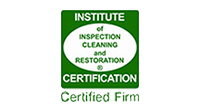Awesome job! Great customer service. Quality, honest work. Love the non-toxic cleaning materials. Thanks James!
Faqs About Professional, Green Carpet Cleaning & More
A Few Things To Know About Our Green Clean Company
During the cleaning, our technicians will wear shoe covers – they take them off each time they go outside and put them back on before stepping onto your carpet. This keeps outside soil outside and off of your carpet. We will leave a pair of shoe covers for each person in the household to wear while carpet dries so you can walk on it right away. The preference is to keep regular traffic off the carpet for a period of 6 hours.
Dry time depends on many factors: weather, amount of soil in carpets before cleaning, if we performed a urine treatment, etc. Some carpets may still feel slightly damp or cool to the touch for up to 24 hours depending on the carpet, weather and soiling conditions. This is normal and will not cause any problems.
The general rule is to wait 24 hours before removing Styrofoam blocks and/or clear tabs that are put in place as a barrier to protect the furniture and carpet.
This is very important – our green carpet cleaning is deep and thorough, and though carpeting may feel dry to the touch, the deep down fibers may still need some extra dry time. Replacing metal or wrought iron furniture onto carpet not yet fully dry will cause rust to occur at the point of contact on the carpet. Replacing mahogany or stained wood furniture will cause the stain to bleed from the furniture onto the carpet and leave a carpet stain.
We start cleaning in the room furthest from the point of entry (generally the front door) and work our way backwards so we don’t walk over anything we have just cleaned. This said, the carpet nearest the front door will be the last carpet cleaned, therefore the longest to fully dry. Test this area by placing a white paper towel on the carpet for 60 seconds. If no moisture has absorbed into the paper towel, your home is completely safe to return furniture to its original position.
No. We use corner guards to protect the corners of walls from our hoses chipping or dinging the paint.
Even more so! Our method actually removes soap left behind by previous cleaning companies. Our process uses all natural degreasers and water softeners to dissolve and emulsify contaminants and soil. Particulates that are not rinsed out dry to a crystallized form allowing easy removal with a good vacuum cleaner. This will leave no soapy, sticky, residue in your carpets.
Yes, we have our system setup where the backing of the carpet or rug is not saturated, therefore no problem with wood floors underneath. No problem with edges either; our rinse does not affect hardwood floors. Oriental rugs and all woven rugs should be cleaned in-plant.
“Filtration Soiling” is the term for those ugly black lines around the baseboards and under doorways. If you have light colored carpet, you may have experienced a dark mark around baseboards, under doors, and especially near the HVAC return. This soiling comes from air passing through the carpet as it is attempting to go through the edge of the carpet pile, microscopic particles of soil are deposited there (hence the term filtration soiling). This occurs over a significant period of time and is not noticed until a buildup has occurred. This type of soiling is difficult to remove because the soil particles are so fine that they penetrate deep into the carpet pile, sometimes into the backing of the carpet. Can it be removed? Sometimes, with special products, time and effort, reasonable results can be achieved, although not in all cases.
To help prevent filtration soiling in the future, vacuum the edges of the carpeting on a regular basis, then wipe with a damp, white terry towel. Be careful around the tackstrip under the edge of the carpeting, you could nick your fingers!
Most carpet manufacturers recommend cleaning with the hot water extraction method at least once every year, and if your carpet is subject to more foot traffic than a two adult household, you should consider having us clean every six months.
This applies whether your carpet looks dirty or not. Carpets are a filter; once they “look” dirty, their ability to filter and hold onto dust, pollens, soil and allergens is at max capacity.
The maximum recommended time between cleaning is once per year. A rare occasion that would exceed this amount would likely be a vacation home used a few times each year. In that situation an audit would be performed to assess the soiling and ventilation condition of the home and surrounding area. For most households, every six months is recommended.
If your home has kids, pets, smokers, or you notice windows and cars parked outside of the home seem to get dirty quickly, you might want to consider a professional cleaning every three months. All of these scenarios increase the contamination indoors and affect your indoor air quality. Cleaning ensures your home stays fresh and odor-free between cleanings.
Absolutely. Berber is a weave, not a particular type of fiber. Berber is simply a type of loop construction that may come in olefin, nylon, wool or a blend. Berber requires a more thorough cleaning than other carpets because the “flushing” action needs to take place to get under, around and through the loops. Other companies that are not as thorough as we are have a lot of problems with Berber because they leave soil behind that “wicks” back to the surface.
Yes, we have special products that we use for wool. We use lower pressure, lower temperature and take special drying precautions for cleaning wool.
Yes, we have special Haitian cotton cleaner, or we can dry-clean it, we take it on a case-by-case basis.
Absolutely!














